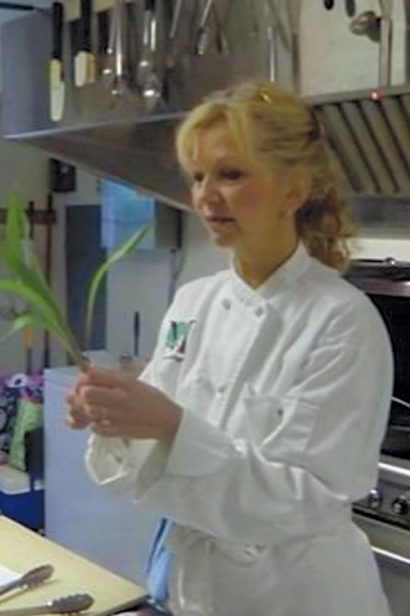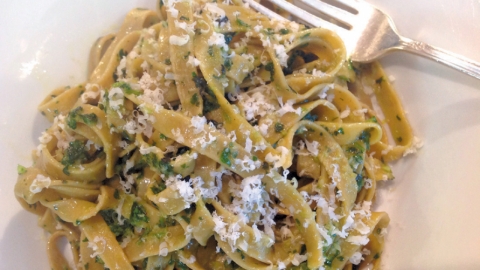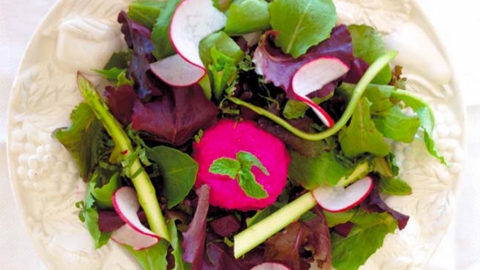Chef Terri Milligan: Spring Greens
When I think of spring greens, I’m not thinking of lettuce. For me, spring means two of my favorite “greens” are now available -- fresh farm asparagus that I stock up on from one of the area’s plentiful farmers markets, and wild ramps, that I get from, well, me! These wild culinary treasures come directly to me from my own backyard.
When I moved to Door County 20 years ago, I expected to find delicious, locally grown produce. It’s one of the many reasons my husband Chris and I selected Door County as the location to open a restaurant. What I didn’t expect was that I would get some of my favorite produce items delivered directly to my back door.
We purchased our Door County home in the late fall unaware that our backyard was literally full of wild ramps. Ramps thrive in rich, moist glades with fertile soil. Apparently, my back yard is a haven for ramp production. When spring came along, I found that I had enough ramps to generously supply our restaurant and still have plenty remaining to replenish my yard for the next year.
Those not familiar with these wild delicacies are missing out on a wonderful culinary gem. Sometimes referred to as “wild leeks”, ramps are native to North America. Found from the East Coast, parts of the Midwest and as far up as Quebec, the top green leaves of spring ramps resemble large lily of the valley leaves. If you are traveling in the West Virginia area in the spring, you may stumble upon one of the many local ramp festivals celebrating this wild edible.
Here in Wisconsin, ramps have a deep history with our state’s Native Americans. Not only were they used as a food source, but also for medicinal purposes. The juice was thought to help relieve the pain and itching of bee stings as well as a method for treating coughs and colds.
Oh, and did I mention that they stink? In fact, the Menominees often referred to them as pikwute sikakushia or the “skunk” plant. When freshly picked, ramps have a strong garlicky odor. The most daunting part of harvesting fresh ramps from my yard was the one-mile car trip transporting my back door harvest to our restaurant. Luckily, blanching or sautéing eliminates the smell.
Picking wild ramps
Picking wild ramps is easy. First, make sure you are allowed to pick them! If you are lucky enough to have access to a ramp patch, use a small shovel or a large trowel to dig them up, root and all. You may want to wear garden shoes or boots. Ramps love woodsy areas and are often found in some mud. And make sure to leave some ramps in the patch. The delicate lavender flowers that are produced from the plants in late summer will go to seed, however it sometimes takes several years for those seeds to produce full size ramps. By removing only a portion of the ramp cluster and leaving some with bulb and roots attached, your patch will be able to reproduce for the next year.
Clearing wild ramps
When you see photos of wild ramps, they’re often in nicely cleaned bunches with their roots neatly trimmed. Like most produce, ramps don’t look like that after they are freshly picked. First you need to wash off the mud from the roots. Then, use a paring knife to take off the root. You will find a thin white skin on the bulb tip that can easily be slipped off. The entire ramp is usable so keep the white bulb and leaves intact. Wrap the cleaned ramp bulbs in a damp paper towel. Although ramps are best used the day they are picked you can keep them in the refrigerator until ready to use. After a day the greens will begin to wilt but they are still
fine to cook with.
Door County Asparagus
At our restaurant I was in for another surprise -- fresh asparagus delivered three times a week directly to my back door from local farmer Mark Carlson of Wildwood Market located right off of Hwy 42 in Liberty Grove. Mark and I created a “make shift” scale and weighed my freshly picked produce right in the back of his truck in our parking lot.
Along with wild ramps, asparagus is one of those local items with a limited harvest time. Like ramps, some lucky homeowners may find a wild asparagus patch in their backyard. However, you won’t need to search far for a local asparagus source here in Door County. You’ll find our many local farmers’ markets brimming with a multitude of colors of asparagus, from purple to asparagus green. (Yes, there was an asparagus green color introduced by Crayola in 1993). Although the purple stalks make a beautiful raw culinary treat, when they’re cooked, they lose their colorful hue.
To peel or not to peel
This much-debated culinary question is one I’m often asked. I see this mostly as a personal preference by the individual chef. The larger the asparagus, the tougher the stalk bottom and the more likely they should be peeled. I usually peel the stalks if the asparagus is 1/2-inch in diameter or larger. Large asparagus stalks tend to be much thicker at the bottom than at the top, so peeling makes them more uniform and they’ll cook more evenly. Snap or cut off the bottom of the asparagus that may be woody. Then, lay the asparagus on a fl at surface and run a vegetable peeler over the thick area. If you are fortunate enough like me to reap some asparagus fresh off the fi eld, you may not need to do any peeling. When freshly picked, the stalks are still moist and tender no matter what the size.
There are a multitude of ways to incorporate ramps and asparagus into your spring cooking. One of my favorite ways to enjoy freshly harvested Door County asparagus is to eat it raw in a shaved asparagus salad. Top the salad off with a colorful timbale (a round molded vegetable and cheese puree) of fresh Door County chevre fl avored with roasted beet puree. Ramp pesto is a great way to use your ramp harvest and be able to enjoy it throughout the year. Freeze the pesto in ice cube trays and, when frozen, pop them out and store in a zip lock freezer bag. Although the color my not be as bright, the fl avors will still ring true.
So take a drive around Door County this spring and enjoy the view. There might be some of my favorite edible spring greens in your future!








